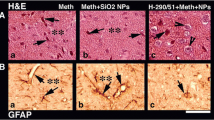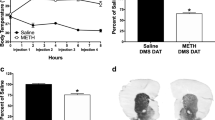Abstract
Methamphetamine (METH) exposure can produce hyperthermia that might lead to toxicity and death. Modafinil is a wake-promoting compound that is also been prescribed off-label to treat METH dependence. Modafinil has shown neuroprotective properties against METH harmful effects in animal models. The goal of the present study was to test if the prevention of hyperthermia might play a role on the neuroprotective actions of modafinil against METH toxicity using various ambient temperatures. METH was administered to female C57BL/6 mice in a binge regimen: 4 × 5 mg/kg, 2 h apart; modafinil (90 mg/kg) was injected twice, 1 h before first and fourth METH injections. Drugs were given at cold ambient temperature (14 °C) or hot ambient temperature (29 °C). Body temperature was measured during treatments. Brains were dissected out 6 days after treatments and processed for tyrosine hydroxylase (TH), dopamine transporter (DAT), GFAP and c-Fos immunohistochemistry. Exposure to hot ambient temperature exacerbated METH toxicity evidenced by striatal reductions in TH and DAT and increased GFAP immmunoreactivity. Modafinil counteracted reductions in TH and DAT, but failed to block astroglial activation. At both ambient temperatures tested modafinil did induce increments in GFAP, but the magnitude was significantly lower than the one induced by METH. Both drugs induced increases in c-Fos positive nuclei; modafinil did not block this effect. Our results suggest that protective effects of modafinil against METH-induced neurotoxicity may be dependent, in part, to its hypothermic effects. Nevertheless, modafinil maintained some protective properties on METH-induced alterations in the striatum at different ambient temperatures.






Similar content being viewed by others
References
Albers DS, Sonsalla PK (1995) Methamphetamine-induced hyperthermia and dopaminergic neurotoxicity in mice: pharmacological profile of protective and nonprotective agents. J Pharmacol Exp Ther 275:1104–1114
Ali SF, Newport GD, Holson RR, Slikker W Jr, Bowyer JF (1994) Low environmental temperatures or pharmacologic agents that produce hypothermia decrease methamphetamine neurotoxicity in mice. Brain Res 658(1–2):33–38
Block ML, Hong JS (2005) Microglia and inflammation-mediated neurodegeneration: multiple triggers with a common mechanism. Prog Neurobiol 76(2):77–98
Bowyer JF, Tank AW, Newport GD, Slikker W Jr, Ali SF, Holson RR (1992) The influence of environmental temperature on the transient effects of methamphetamine on dopamine levels and dopamine release in rat striatum. J Pharmacol Exp Ther 260(2):817–824
Bowyer JF, Gough B, Slikker W Jr, Lipe GW, Newport GD, Holson RR (1993) Effects of a cold environment or age on methamphetamine-induced dopamine release in the caudate putamen of female rats. Pharmacol Biochem Behav 44(1):87–98
Bowyer JF, Davies DL, Schmued L, Broening HW, Newport GD, Slikker W, Holson RR (1994) Further studies of the role of hyperthermia in methamphetamine neurotoxicity. J Pharmacol Exp Ther 268:1571–1580
Bowyer JF, Holson RR, Miller DB, O’Callaghan JP (2001) Phenobarbital and dizocilpine can block methamphetamine-induced neurotoxicity in mice by mechanisms that are independent of thermoregulation. Brain Res 919:179–183
Bowyer JF, Robinson B, Ali S, Schmued LC (2008) Neurotoxic-related changes in tyrosine hydroxylase, microglia, myelin, and the blood–brain barrier in the caudate-putamen from acute methamphetamine exposure. Synapse 62:193–204. doi:10.1002/syn.20478
Cadet JL, Brannock C (1998) Free radicals and the pathobiology of brain dopamine systems. Neurochem Int 32(2):117–131
Cadet JL, Jayanthi S, McCoy MT, Ladenheim B, Saint-Preux F, Lehrmann E, De S, Becker KG, Brannock C (2013) Genome-wide profiling identifies a subset of methamphetamine (METH)-induced genes associated with METH-induced increased H4K5Ac binding in the rat striatum. BMC Genom 14:545. doi:10.1186/1471-2164-14-545
Cadet JL, Bisagno V, Milroy CM (2014) Neuropathology of substance use disorders. Acta Neuropathol 127(1):91–107. doi:10.1007/s00401-013-1221-7
Callahan BT, Cord BJ, Yuan J, McCann UD, Ricaurte GA (2001) Inhibitors of Na(+)/H(+) and Na(+)/Ca(2+) exchange potentiate methamphetamine-induced dopamine neurotoxicity: possible role of ionic dysregulation in methamphetamine neurotoxicity. J Neurochem 77:1348–1362
Cass WA, Smith MP, Peters LE (2006) Calcitriol protects against the dopamine- and serotonin-depleting effects of neurotoxic doses of methamphetamine. Ann N Y Acad Sci 1074:261–271
Chipana C, Torres I, Camarasa J, Pubill D, Escubedo E (2008) Memantine protects against amphetamine derivatives-induced neurotoxic damage in rodents. Neuropharmacology 54:1254–1263. doi:10.1016/j.neuropharm.2008.04.003
Cubells JF, Rayport S, Rajendran G, Sulzer D (1994) Methamphetamine neurotoxicity involves vacuolation of endocytic organelles and dopamine-dependent intracellular oxidative stress. J Neurosci 14(4):2260–2271
Deng X, Ladenheim B, Tsao LI, Cadet JL (1999) Null mutation of c-fos causes exacerbation of methamphetamine-induced neurotoxicity. J Neurosci 19:10107–10115
Deng X, Ladenheim B, Jayanthi S, Cadet JL (2007) Methamphetamine administration causes death of dopaminergic neurons in the mouse olfactory bulb. Biol Psychiatry 61:1235–1243. doi:10.1016/j.biopsych.2006.09.010
Donovan DM, Miner LL, Perry MP, Revay RS, Sharpe LG, Przedborski S, Kostic V, Philpot RM, Kirstein CL, Rothman RB, Schindler CW, Uhl GR (1999) Cocaine reward and MPTP toxicity: alteration by regional variant dopamine transporter overexpression. Brain Res Mol Brain Res 73(1–2):37–49
Fiocchi EM, Lin YG, Aimone L, Gruner JA, Flood DG (2009) Armodafinil promotes wakefulness and activates Fos in rat brain. Pharmacol Biochem Behav 92(3):549–557. doi:10.1016/j.pbb.2009.02.006
Flora G, Lee YW, Nath A, Maragos W, Hennig B, Toborek M (2002) Methamphetamine-induced TNF-alpha gene expression and activation of AP-1 in discrete regions of mouse brain: potential role of reactive oxygen intermediates and lipid peroxidation. Neuromolecular Med 2(1):71–85
Fumagalli F, Gainetdinov RR, Valenzano KJ, Caron MG (1998) Role of dopamine transporter in methamphetamine-induced neurotoxicity: evidence from mice lacking the transporter. J Neurosci 18(13):4861–4869
Gainetdinov RR, Fumagalli F, Jones SR, Caron MG (1997) Dopamine transporter is required for in vivo MPTP neurotoxicity: evidence from mice lacking the transporter. J Neurochem 69(3):1322–1325
Garcia-Rill E, Heister DS, Ye M, Charlesworth A, Hayar A (2007) Electrical coupling: novel mechanism for sleep-wake control. Sleep 30(11):1405–1414
González B, Raineri M, Cadet JL, García-Rill E, Urbano FJ, Bisagno V (2014) Modafinil improves methamphetamine-induced object recognition deficits and restores prefrontal cortex ERK signaling in mice. Neuropharmacology. doi:10.1016/j.neuropharm.2014.02.002
Gozzi A, Colavito V, Seke Etet PF, Montanari D, Fiorini S, Tambalo S, Bifone A, Zucconi GG, Bentivoglio M (2012) Modulation of fronto-cortical activity by modafinil: a functional imaging and fos study in the rat. Neuropsychopharmacology 37(3):822–837
Gruner JA, Marcy VR, Lin YG, Bozyczko-Coyne D, Marino MJ et al (2009) The roles of dopamine transport inhibition and dopamine release facilitation in wake enhancement and rebound hypersomnolence induced by dopaminergic agents. Sleep 32:1425–1438
Krasnova IN, Cadet JL (2009) Methamphetamine toxicity and messengers of death. Brain Res Rev 60(2):340–379
Ladenheim B, Krasnova IN, Deng X, Oyler JM, Polettini A, Moran TH, Huestis MA, Cadet JL (2000) Methamphetamine-induced neurotoxicity is attenuated in transgenic mice with a null mutation for interleukin-6. Mol Pharmacol 58(6):1247–1256
Madras BK, Xie Z, Lin Z, Jassen A, Panas H, Lynch L, Johnson R, Livni E, Spencer TJ, Bonab AA, Miller GM, Fischman AJ (2006) Modafinil occupies dopamine and norepinephrine transporters in vivo and modulates the transporters and trace amine activity in vitro. J Pharmacol Exp Ther 319(2):561–569
Martin TA, Jayanthi S, McCoy MT, Brannock C, Ladenheim B, Garrett T, Lehrmann E, Becker KG, Cadet JL (2012) Methamphetamine causes differential alterations in gene expression and patterns of histone acetylation/hypoacetylation in the rat nucleus accumbens. PLoS One 7(3):e34236. doi:10.1371/journal.pone.0034236
Matsumoto RR, Seminerio MJ, Turner RC, Robson MJ, Nguyen L, Miller DB, O’Callaghan JP (2014) Methamphetamine-induced toxicity: an updated review on issues related to hyperthermia. Pharmacol Ther. doi:10.1016/j.pharmthera.2014.05.001
Mereu M, Bonci A, Newman AH, Tanda G (2013) The neurobiology of modafinil as an enhancer of cognitive performance and a potential treatment for substance use disorders. Psychopharmacology 229(3):415–434
Miller DB, O’Callaghan JP (1994) Environment-, drug- and stress-induced alterations in body temperature affect the neurotoxicity of substituted amphetamines in the C57BL/6J mouse. J Pharmacol Exp Ther 270(2):752–760
Milligan ED, Watkins LR (2009) Pathological and protective roles of glia in chronic pain. Nat Rev Neurosci 10(1):23–36. doi:10.1038/nrn2533
Minzenberg MJ, Carter CS (2008) Modafinil: a review of neurochemical actions and effects on cognition. Neuropsychopharmacology 33(7):1477–1502
Namiki M, Mori T, Sawaguchi T, Ito S, Suzuki T (2005) Underlying mechanism of combined effect of methamphetamine and morphine on lethality in mice and therapeutic potential of cooling. J Pharmacol Sci 99(2):168–176
O’Callaghan JP, Miller DB (1994) Neurotoxicity profiles of substituted amphetamines in the C57BL/6J mouse. J Pharmacol Exp Ther 270(2):741–751
Okuro M, Fujiki N, Kotorii N, Ishimaru Y, Sokoloff P, Nishino S (2010) Effects of paraxanthine and caffeine on sleep, locomotor activity, and body temperature in orexin/ataxin-3 transgenic narcoleptic mice. Sleep 33(7):930–942
Pu C, Fisher JE, Cappon GD, Vorhees CV (1994) The effects of amfonelic acid, a dopamine uptake inhibitor, on methamphetamine-induced dopaminergic terminal degeneration and astrocytic response in rat striatum. Brain Res 649(1–2):217–224
Raineri M, Peskin V, Goitia B, Taravini IR, Giorgeri S, Urbano FJ, Bisagno V (2011) Attenuated methamphetamine induced neurotoxicity by modafinil administration in mice. Synapse 65(10):1087–1098
Raineri M, Gonzalez B, Goitia B, Garcia-Rill E, Krasnova IN, Cadet JL, Urbano FJ, Bisagno V (2012) Modafinil abrogates methamphetamine-induced neuroinflammation and apoptotic effects in the mouse striatum. PLoS ONE 7(10):e46599
Reichel CM, Gilstrap MG, Ramsey LA, See RE (2014) Modafinil restores methamphetamine induced object-in-place memory deficits in rats independent of glutamate N-methyl-d-aspartate receptor expression. Drug Alcohol Depend 134:115–122. doi:10.1016/j.drugalcdep.2013.09.018
Riddle EL, Fleckenstein AE, Hanson GR (2006) Mechanisms of methamphetamine-induced dopaminergic neurotoxicity. AAPS J 8(2):E413–E418
Sagar SM, Sharp FR, Curran T (1988) Expression of c-fos protein in brain: metabolic mapping at the cellular level. Science 240(4857):1328–1331
Sahu S, Kauser H, Ray K, Kishore K, Kumar S, Panjwani U (2013) Caffeine and modafinil promote adult neuronal cell proliferation during 48 h of total sleep deprivation in rat dentate gyrus. Exp Neurol 248:470–481. doi:10.1016/j.expneurol.2013.07.021
Schep LJ, Slaughter RJ, Beasley DM (2010) The clinical toxicology of metamfetamine. Clin Toxicol (Phila) 48:675–694
Song DD, Haber SN (2000) Striatal responses to partial dopaminergic lesion: evidence for compensatory sprouting. J Neurosci 20:5102–5114
Urbano FJ, Leznik E, Llinás RR (2007) Modafinil enhances thalamocortical activity by increasing neuronal electrotonic coupling. Proc Natl Acad Sci USA 104(30):12554–12559
Volkow ND, Chang L, Wang GJ, Fowler JS, Leonido-Yee M, Franceschi D et al (2001) Association of dopamine transporter reduction with psychomotor impairment in methamphetamine abusers. Am J Psychiatry 158:377–382
Volkow ND, Chang L, Wang GJ, Fowler JS, Franceschi D, Sedler M et al (2009) Effects of modafinil on dopamine and dopamine transporters in the male human brain: clinical implications. JAMA 301(11):1148–1154
Wilson JM, Kalasinsky KS, Levey AI, Bergeron C, Reiber G, Anthony RM, Schmunk GA, Shannak K, Haycock JW, Kish SJ (1996) Striatal dopamine nerve terminal markers in human, chronic methamphetamine users. Nat Med 2(6):699–703
Xie T, McCann UD, Kim S, Yuan J, Ricaurte GA (2000) Effect of temperature on dopamine transporter function and intracellular accumulation of methamphetamine: implications for methamphetamine-induced dopaminergic neurotoxicity. J Neurosci 20(20):7838–7845
Zhang L, Kitaichi K, Fujimoto Y, Nakayama H, Shimizu E, Iyo M, Hashimoto K (2006) Protective effects of minocycline on behavioral changes and neurotoxicity in mice after administration of methamphetamine. Prog Neuropsychopharmacol Biol Psychiatry 30:1381–1393
Zolkowska D, Jain R, Rothman RB, Partilla JS, Roth BL, Setola V, Prisinzano TE, Baumann MH (2009) Evidence for the involvement of dopamine transporters in behavioral stimulant effects of modafinil. J Pharmacol Exp Ther 329:738–746
Acknowledgments
Dr. Bisagno has been authorized to study drug abuse substances in animal models by A.N.M.A.T. (National Board of Medicine Food and Medical Technology, Ministerio de Salud, Argentina). Dr. Betina Gonzalez is a recipient of a Postdoctoral Award from Fundación Bunge y Born. This work is supported by Grants PIP 11420100100072, PICT 2012-0924, PICT 2012-1769, Argentina, and by NIH awards P20 GM103425 and P230 GM110702 to the Center for Translational Neuroscience.
Conflict of interest
Authors also report no conflict of interest, financial or otherwise, related directly or indirectly to this work.
Author information
Authors and Affiliations
Corresponding author
Rights and permissions
About this article
Cite this article
Raineri, M., González, B., Rivero-Echeto, C. et al. Differential Effects of Environment-Induced Changes in Body Temperature on Modafinil’s Actions Against Methamphetamine-Induced Striatal Toxicity in Mice. Neurotox Res 27, 71–83 (2015). https://doi.org/10.1007/s12640-014-9493-9
Received:
Revised:
Accepted:
Published:
Issue Date:
DOI: https://doi.org/10.1007/s12640-014-9493-9




